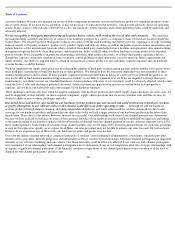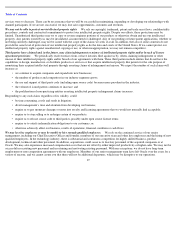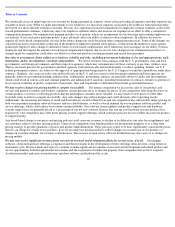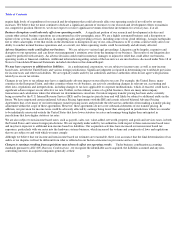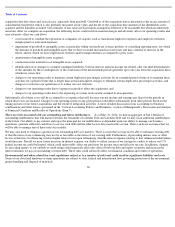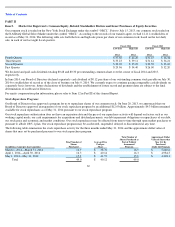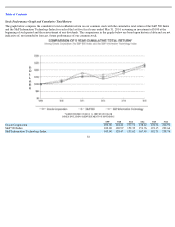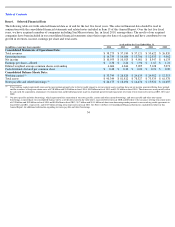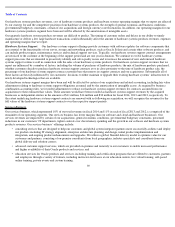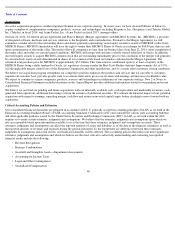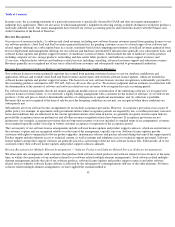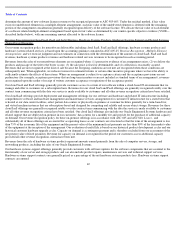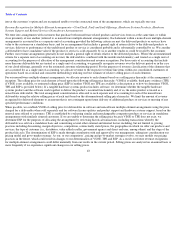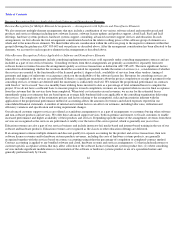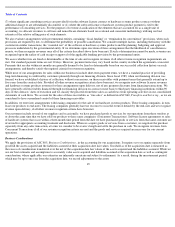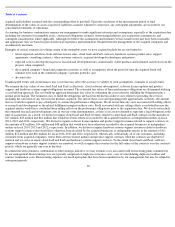Oracle 2013 Annual Report Download - page 40
Download and view the complete annual report
Please find page 40 of the 2013 Oracle annual report below. You can navigate through the pages in the report by either clicking on the pages listed below, or by using the keyword search tool below to find specific information within the annual report.
Table of Contents
We are organized into three businesses—software and cloud, hardware systems and services—which are further divided into certain operating
segments. Each of our businesses and operating segments has unique characteristics and faces different opportunities and challenges. Although
we report our actual results in U.S. Dollars, we conduct a significant number of transactions in currencies other than U.S. Dollars. Therefore, we
present constant currency information to provide a framework for assessing how our underlying businesses performed excluding the effects of
foreign currency rate fluctuations. Our cloud infrastructure-as-a-service segment was established during our fiscal quarter ended May 31, 2014.
Our fiscal 2014 results, and historical results for fiscal 2013 and 2012, reflect this new segment structure and will continue prospectively in our
future filings. See Note 16 of Notes to Consolidated Financial Statements, included elsewhere in this Annual Report, for additional information
related to our operating segments. An overview of our three businesses and related operating segments follows.
Software and Cloud Business
Our software and cloud business, which represented 76%, 75% and 72% of our total revenues in fiscal 2014, 2013 and 2012, respectively, is
comprised of three operating segments: (1) new software licenses and cloud software subscriptions, (2) cloud infrastructure-as-a-service and
(3) software license updates and product support. On a constant currency basis, we expect that our software and cloud business’ total revenues
generally will continue to increase due to continued demand for our software products and subscription offerings, our software license updates
and product support offerings, including the high percentage of customers that renew their software license updates and product support
contracts, and our acquisitions, which should allow us to grow our profits and continue to make investments in research and development.
New Software Licenses and Cloud Software Subscriptions:
We license our database and middleware, as well as our application software, and
provide access to a broad range of our software through Oracle Cloud Software-as-a-Service (SaaS) and Oracle Cloud Platform-as-a-Service
(PaaS) offerings (SaaS and PaaS collectively are referred to as cloud software subscriptions). Our software offerings are substantially built on a
standards-
based, integrated architecture that is designed to help customers reduce the cost and complexity of their IT infrastructure. Our software
offerings are substantially designed to operate on both single server and clustered server configurations for cloud or on-
premise IT environments,
and to support a choice of operating systems including Oracle Solaris, Oracle Linux, Microsoft Windows and third party UNIX products, among
others. Our customers include businesses of many sizes, government agencies, educational institutions and resellers. We market and sell our
software products and services to these customers with a sales force positioned to offer the combinations that best fit their needs. We enable
customers to evolve and transform to substantially any IT environment at whatever pace is most appropriate for them.
The growth in our new software licenses and our SaaS and PaaS revenues that we report is affected by the strength of general economic and
business conditions, governmental budgetary constraints, the competitive position of our software offerings, our acquisitions and foreign
currency fluctuations. The substantial majority of our new software licenses transactions are characterized by long sales cycles and the timing of
a few large software license transactions can substantially affect our quarterly new software licenses revenues. New software licenses and cloud
software subscriptions revenues represented 28% of our total revenues in each of fiscal 2014 and 2013 and 27% in fiscal 2012. Our cloud
software subscriptions contracts, which consist of SaaS and PaaS arrangements, are generally one to three years in duration and we strive to
renew these contracts when they are eligible for renewal. Our new software licenses and cloud software subscriptions segment’s margin has
historically trended upward over the course of the four quarters within a particular fiscal year due to the historical upward trend of our new
software licenses revenues over those quarterly periods and because the majority of our costs for this segment are predominantly fixed in the
short-term. However, our new software licenses and cloud software subscriptions segment’s margin has been and will continue to be affected by
the fair value adjustments relating to the cloud software subscriptions obligations that we assumed in our business combinations (described
further below) and by the amortization of intangible assets associated with companies and technologies that we have acquired.
For certain of our acquired businesses, we recorded adjustments to reduce the cloud SaaS and PaaS obligations to their estimated fair values at
the acquisition dates. As a result, as required by business combination accounting rules, we did not recognize cloud SaaS and PaaS revenues
related to acquired contracts that would have been otherwise recorded by the acquired businesses as independent entities in the amounts of $17
million, $45 million
36


